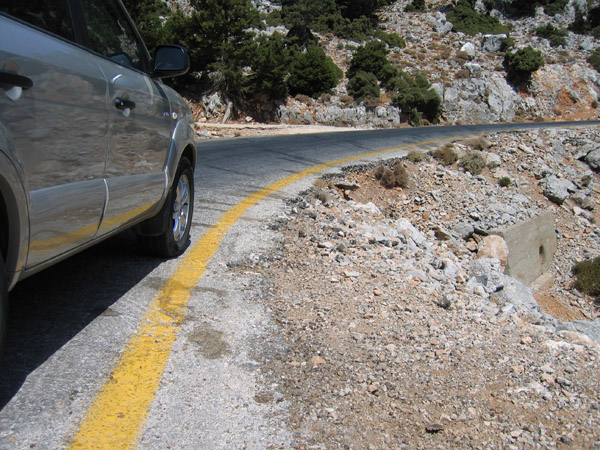
EuroRAP has come up with minimum safety standards and also has a protocol for scoring roads. This uses 70 criteria to give a road, or section of road, a star rating similar to that used by Euro NCAP for cars
Some developed countries are far from leading the way when it comes to making road infrastructure safe. In fact, says the Road Safety Foundation's Joanne Hill, they learn a lot from what is happening in emergent nations.
One of the biggest, she says, is about complacency. For instance, the UK has traditionally had some of the world's safest roads but an engrained assumption that this will always be so is actually leading to a situation where it is losing ground. At the same time, the uncompromised, 'Vision Zero'-type approach- being taken to safety in countries such as Sweden, the Netherlands and even some developing countries makes for embarrassing comparisons.
"There's much more attention paid to the detail of safety in other modes of transport, such as aviation and maritime, than there is when it comes to roads," Hill says. "There's a lot of emphasis on enforcement and education but too little weighting is given to the infrastructure itself.
"Some of that stems from the acceptance of the 'inevitability' of crashes and accidents across all stakeholders and road users. In the UK, localism - devolving government down to the lowest level - isn't helping in that respect because there's no maintenance of a longranging safety goal as a result.
"A 'Safe Systems' approach works. Euro NCAP, for instance, is forcing change in the consumer market and there are a lot of behavioural programmes championing changes in drivers' habits. But there's an infrastructure gap, in part because of an attitude of, 'It's not roads that kill, it's people.' Well, people will still make mistakes even when driving within the law - when not exceeding the speed limit, sober, or not using a mobile phone whilst driving. Formula 1 provides a good example of how the road, vehicle and user can work together."
Short-termism is an issue: "A big finding of our report is that evaluation of road safety schemes is generally based on the first-year rate of return on investment. That's a very short-sighted view, especially when you consider that properly maintained infrastructure measures can continue to protect and save lives for decades. We need to evaluate based on whole-life costs, not least because by comparison with, say, rail or aviation, the biggest returns on investment are achievable on the roads. There's still a lot to gain from putting the roads right and it's eminently affordable; many of the elements of a well-orchestrated, national campaign of road safety are no more than the result of routine maintenance."
Realisation
Recent economic conditions have resulted in greater competition for fewer funds.With cost-effectiveness and efficiency to the fore, a big disadvantage for the road sector is a lack of data on where true costs fall, according to Hill.
"There's a huge lack of data and significant under-reporting of accidents.
We know that from comparisons of police and hospital records, and people also look to protect their no-claims bonuses on their car insurance.
"The police officers at the scene of an incident aren't qualified to predict medical outcomes and in the UK, for example, there is no long-term costing of medical care beyond 18 months. For any number of reasons, we're seeing more young drivers becoming involved in the types of incidents which need prolonged medical care. That increases costs significantly. There are also other costs to consider - clearing up after an incident, taking statements, informing next of kin, attending hospitals and courts, and so on. All of these shortfalls are paid for by society. But they need to be built into reporting in order to allow true costs to be seen.
"The scale of the difference in costs is a worry and some countries, such as Sweden and the Netherlands, do rather better than, for instance, the UK."
Seminal report
Hill sees the OECD's 2008 'Towards Zero' report as being pivotal, identifying institutional management changes as being an international problem."Effective interventions require us to build economic cases for investment.
That goes back to the point about firstyear rates of return; many developing or lower and middle-income countries are now engaging in whole-life costing, and yet many developed and wealthier countries aren't. Why not? We need to look again at value-engineering and best use of resources, as well as the accountability of crash costs spread across many different agencies."
That this is an international problem raises the issue of who should take a lead, however.
"In terms of which countries are taking a lead on best practice, it's a real mixed bag. We need to look again at best practice for road design and layout.If the automotive OEMs are going to use ITS systems to read roads, we need to give greater consideration to crossborder and international traffic.
Inconsistency of signage and road markings is a problem - an awful lot of work is needed, for example, on centreline management because at the moment too much of the onus of situational management is on the driver.
"Ideally leadership should come from government but I doubt that'll happen.
Take the UK as an example: the
"Perhaps it needs to be someone on the outside looking in, such as the OECD or the development banks. That would reflect what's happening in developing countries. It is harder in developed nations, however; there are established systems and it would be difficult for someone independent to come in and start to call the shots. Europe, via the European Commission, has established frameworks for road safety but, again, these are more about enforcement and education than infrastructure."
Change
Any realistic programme of change has to recognise that things can be done to improve safety and take a view on longterm investment, therefore.Hill: "Broadly, 10 per cent of our roads are where 50 per cent of fatal crashes occur.
"We need to combine ways of looking at risk with historical incident data.
EuroRAP has scoped out the idea of minimum safety standards and also has a protocol for scoring roads. This uses 70 criteria to give a road, or section of road, a star rating similar to that used by Euro NCAP for cars.
"We're advocating that, at a minimum, a motorway should have a five-star rating, a dual carriageway should have a four-star rating, and a single-lane road should have a three-star rating. The Netherlands has committed to three-star national roads by 2020, so there are precedents. In the UK, our report shows that it's possible to achieve something like this over the course of a 10-year programme of routine maintenance.
"The highest-risk routes need to be targeted and we need to improve our ideas of route treatment. That means getting away from just addressing cluster sites and looking at the safety of a whole route rather than focusing on accident black-spots.
"Making funding conditional might also help - effectively, means-testing projects.
Reductions in funding mean that we're losing evaluation expertise, however, and much of the Foundation's work centres on finding out what's been done and where - a problem with many local authorities is that they don't know what's going on elsewhere, and parochialism is an increasing concern.
"Committee decisions don't help those at the sharp end who have a better awareness of what needs to be done. Pet projects continue to get in the way, which is especially galling when you consider that we're only talking about small amounts of money being needed for many of the necessary infrastructure changes; many senior decision-makers remain ignorant of that fact. Change will take years but the moment you take your foot off the pedal you start to slip back."
End game
"In terms of where we want to get to, a 'Vision Zero'-type approach is being adopted by many nations. It might not be possible to get there but that has to at least be an aim, not rather arbitrary casualty reduction targets where we should be somehow pleased because we were 'within 10 per cent of our goal'."Countries do need to work together, adopting and adapting, but we can't simply pick and place solutions because of geographical and cultural differences.
"There's also a real need for more case studies but a big issue in road safety is that in general only that which works is reported. It's equally as important to know what doesn't work.
"There's an awful lot of good work being done. Equally, there's a worry among some in the public sector of being seen to be becoming too close to certain manufacturers and of somehow showing preference; but that's an avenue, and only one avenue, which needs to be explored further.
"However, if we can set aggressive goals based on balanced economic cases then we'll be well on our way to seeing returns on investments in road infrastructure which are far greater than for other areas of infrastructure and the economy as a whole."







